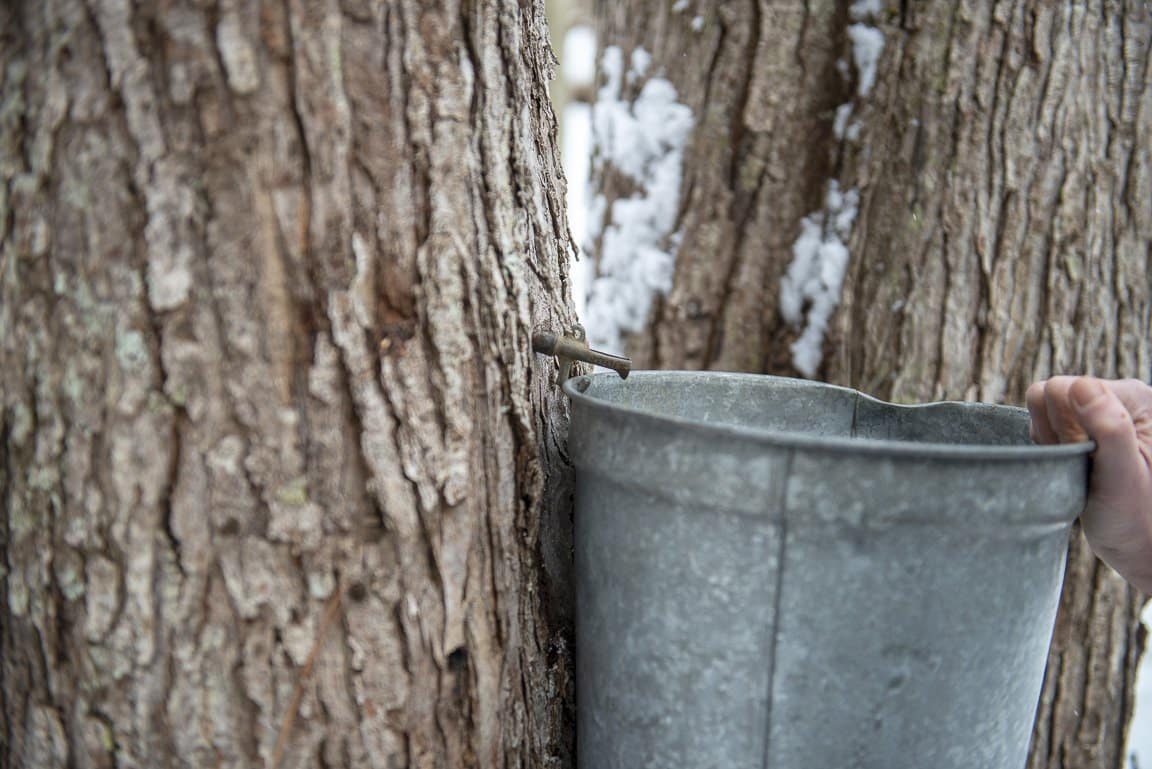Maple sap runs in the late winter or early spring time, when the nights are freezing and the days are warm. But what exactly causes the sap to run out of the tree and into our buckets?
As many sugar makers know, the time for collecting sap from a maple tree is in late winter or early spring, when the temperatures are warm during the day and freezing at night. Here in Vermont, this is typically sometime between Late January and early April, depending on the weather. (For more info on how and when to tap, check out our previous blog posts!) Basically, the freeze thaw cycle at this time of year causes pressure changes in the tree that allows the sap to flow out of the tree and into our buckets. But what exactly is this pressure, and how does the freeze/thaw cycle make sap move in the tree? In order to understand that, we needed to understand how sap flows in a tree, why it flows, and what makes maple trees so special.
All trees need water to survive. The trees draw water up through their roots; the water then flows from the roots up the trunk to the branches and leaves of the tree. The water flows through the xylem, which are long thin hollow cells that connect to one another to form little conduits from the roots to the branches of the tree. This is important for photosynthesis, which is how the tree creates energy.
Photosynthesis happens in the leaves of the tree when microscopic openings in the leaves, or stomata, open up to gather carbon dioxide, which is used to create sugars to store energy. While the stomata are open, water escapes through the small opening by a process called transpiration. While water is escaping out of the leaves, a void is left behind, and water is pulled up the through the xylem, (conduits) of the tree to fill that void. These sugars are then stored in the branches, trunk and roots of the tree, as starches, for later use.
The starches are stored in the ray cells of the tree, which are the living cells and the dead wood fiber cells that surround the xylem (conduits) in the trunk of the tree. In the springtime when the tree needs energy to grow, it releases an enzyme that transforms those starches into sugar which is then released into the sap-filled conduit cells. The purpose of this release is to move those sugars to the top branches of the tree and use that energy to grow leaves in the spring.
So, what makes maple trees so special? In most trees, the cells in the rays are filled with water, but in maple trees these cells are filled with gas. When most trees freeze at night, the water filled cells, freeze, pushing the sap out of the tree. When a maple tree freezes at night, the sap filled conduits freeze and expand. During the freezing process, the gas filled cells in the rays are condensed, or made smaller, and a frost, that contains sugar, forms on the sides of the ray cells. This freezing and condensing of gas cells in the tree creates a negative pressure in the tree, which then pulls more sap up the tree, from the roots.
When the tree thaws, the frozen sugars attached to the ray cells then reenter the conduit cells, while the gas filled cells expand. This expansion causes a positive pressure in the tree, pushing the sap around and out of the tree. The maple tree has several ways in which it gets rid of this pressure, including evaporation off of branches and through any cracks or weak points in the tree, including our tap holes.
This process then continues, for several days or weeks in the early spring, freezing or negative pressure at night and thawing or positive pressure during the day; pulling of sap into the tree at night and pushing of sap around and out of the tree during the day. The maple tree makes and stores more sugar than it will need for the following spring due to the loss of sap through this process. So, when the maple tree loses a bit of sap during the positive pressure times, it still has plenty to be healthy and grow.
So why does the sap stop flowing then? When this freeze thaw cycle stops, the positive pressure in the tree stops, and so the sap stops running out of your tap hole. It’s this alternation between positive and negative pressure that pushes the sap out of the tree, and without that positive pressure, the tree just keeps its sap flowing slowly up the tree through its xylem (conduits). Many maple syrup producers will pull their taps and stop collecting sap when the trees start to bud, even if there is still sap flowing. This is because once the tree starts to bud, the sap makes a syrup with a “off” flavor that most people don’t enjoy.
So there you have it! Maple trees are special because the cells in their trees are filled with gas instead of water. During the freezing nights, those gas bubbles condense and pull sap into the conduit cells of the tree. During the warmer days, the gas in the cells expand and push the sap out of our tap holes in into our buckets. When the alternation of freezing nights and warm days stops, the tree no longer has this change in pressure, and the sap stops flowing out of the tree.
Now, when your making your syrup on your seedling or sapling pan maybe you’ll have a renewed respect for the final, sweet product!

